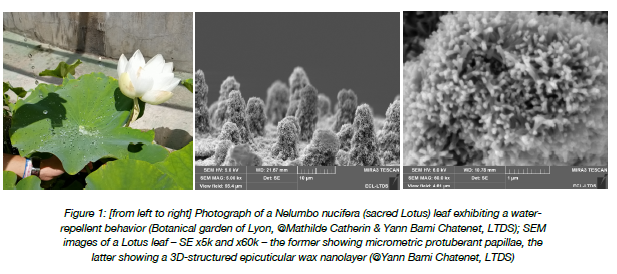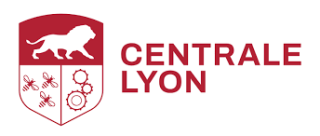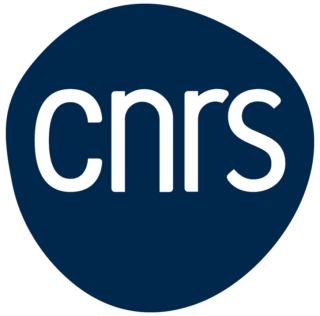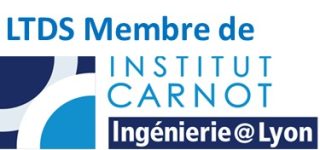PHD PROPOSAL – 2025-2028
Laboratoire de Tribologie et Dynamique des Systèmes | UMR 5513 | Ecole Centrale de Lyon
“Bio-inspired low adhesion surfaces through lotus-like surface texturing”
Scientific context:
After exceeding the planetary limit for green water (absorbed by plants and vegetation) in 2022, the limit for blue water (rivers, lakes, groundwater) was exceeded in 2023 [1]. This recent
study from Richardson et al., combined with other factors such as that one in three people in the world has no access to safe water, makes water resource management a crucial issue for
humanity [2]. While the issue of access to and preservation of water resources until recently concerned the world’s arid zones, the context of climate change is generalizing these questions to the whole of humankind. In the summer of 2022, when France experienced its worst drought in over fifty years, more than a thousand communes had to implement exceptional water supply management measures (supplies by trucks or bottles) [3]
The issue of water resource management is becoming a major social issue for environmental, strategic and economic reasons. In France, 20% of the drinking water consumed per
inhabitant is dedicated to the operation of toilets [4]. This represents about 2 million m3 of Denis MAZUYER, Juliette CAYER-BARRIOZ, Stéphane VALETTE – PhD proposal – LTDS 2
water per year. Thus, the issue of the development of dry toilets is a major issue in the management of water resources. In traditional toilets, water is used to transport urine and
faeces. In dry toilets, the routing of excreta is based on the properties of the surfaces involved in the system and particularly the management of the adhesion of materials on them. Nature
has been able to develop low-adhesion strategies through the development of superhydrophobic surfaces, of the dry type, such as the lotus leaf, or of the soaked type such as the surfaces of carnivorous plants of the Nepenthes family.
This thesis topic proposes to study the strategy of dry superhydrophobic surfaces with low adhesion, of the lotus leaf type, for the development of functional surfaces with
controlled adhesion in the framework of dry toilets.
In order to better understand how liquid-repellency and low adhesion surfaces may be designed, our team in the Laboratory of Tribology and Systems Dynamics (LTDS) of the Ecole Centrale de Lyon is working both on the development of new characterization methods and on the manufacturing of complex textured surfaces through various processes (femtosecond laser, additive manufacturing, polymer replications, photolithography, …). Our scientific approach is based on the study of living systems through a biomimetic approach in order to propose bio-inspired functionalized surfaces.
- Barthlott W. et al, « Plant surfaces: structures and functions for biomimetic innovations », Nanomicro Lett., 9, 2017, 1-40
- Bami Chatenet Y. and Valette S., « Mechanical criteria and analytical modeling of mixed-state wetting on multiscale surfaces: Of the importance of nanoscale topography for water-repellency »,
Colloids Surf. A: Physicochem. Eng. Asp., 672, 2023, 131752 - Bami Chatenet Y. and Valette S., « Critical pressure versus mechanical criteria for the analytical modeling of wetting on multiscale surfaces « , Colloids Surf. A: Physicochem. Eng. Asp., 2023
[Accepted manuscript. DOI: 10.1016/j.colsurfa.2023.132877] - https://www.services.eaufrance.fr/economie-d-eau
Objective of the PhD:
The purpose of this thesis project is to propose a new generation of controlled low-adhesion surfaces inspired by surfaces from the living world. The work will consist of the study of superrepellent
surfaces present in nature, such as the sacred lotus leaf, and in the possibility of transferring such functions to the surfaces involved in dry toilets. The work will be mainly experimental and will consist of the design, manufacture and characterization of dry super-repellent surfaces. The physics of surface wettability and the morphology-wettabilityadhesion relationships will be studied in depth.
PhD run:
Attached to the LTDS laboratory from Ecole Centrale de Lyon, the student will have to work in a scientific multi-disciplinary environment from surface characterization to physics of wetting. The access to high-level equipment at the LTDS and the SURFAB platform will provide to the student a high-level research experience. The thesis is part of a national project funded by ADEME and led by SANIS¨HERE, a company located in the Auvergne Rhône-Alpes region, which develops and installs dry toilets.
Candidate profile:
From an academic level of master of science in physics/mechanics/materials or from a school of engineers, the candidate will need to have a decided taste for experiments. He/she will have to demonstrate a large scientific curiosity due to the multidisciplinary character of this internship. The student will have to demonstrate rigor, independence, and capacity to restitute information and obtained results. Qualities in oral and written redaction in French and in English are expected. The final report will have to be written in English.
Terms and conditions of the internship:
Supervisory staff: Denis MAZUYER
Juliette CAYER-BARRIOZ
Stéphane VALETTE
Duration: 36 months, start in the 3rd quarter of 2025
Location: Laboratoire de Tribologie et Dynamique des Systèmes / Ecole Centrale de Lyon, Ecully campus
Contact:
- Denis MAZUYER, denis.mazuyer@ec-lyon.fr
- Juliette CAYER-BARRIOZ, juliette.cayer-barrioz@ec-lyon.fr
- Stéphane VALETTE, stephane.valette@ec-lyon.fr





